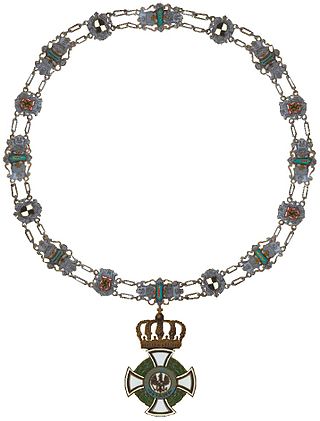Related Research Articles
The Marcel Benoist Prize, offered by the Marcel Benoist Foundation, is a monetary prize that has been offered annually since 1920 to a scientist of Swiss nationality or residency who has made the most useful scientific discovery. Emphasis is placed on those discoveries affecting human life. Since 1997, candidates in the humanities have also been eligible for the prize.

A Generaloberst was the second-highest general officer rank in the German Reichswehr and Wehrmacht, the Austro-Hungarian Common Army, the East German National People's Army and in their respective police services. The rank was equal to a four-star full general but below a general field marshal. The rank was equivalent to a Generaladmiral in the Kriegsmarine until 1945 or to a Flottenadmiral in the Volksmarine until 1990. It was the highest ordinary military rank and the highest military rank awarded in peacetime; the higher rank of general field marshal was awarded only in wartime by the head of state. In general, a Generaloberst had the same privileges as a general field marshal.
The National Prize of the German Democratic Republic (East Germany) (German: Nationalpreis der Deutschen Demokratischen Republik) was an award of the German Democratic Republic (GDR) given out in three different classes for scientific, artistic, and other meritorious achievement. With scientific achievements, it was often given to entire research groups rather than individual scientists.

The House Order of Hohenzollern was a dynastic order of knighthood of the House of Hohenzollern awarded to military commissioned officers and civilians of comparable status. Associated with the various versions of the order were crosses and medals which could be awarded to lower-ranking soldiers and civilians.

This is a list of members of the 4th Reichstag – the parliament of the Weimar Republic, whose members were elected in the 1928 federal election and served in office from 1928 until its dissolution in 1930.
The German Mathematical Society is the main professional society of German mathematicians and represents German mathematics within the European Mathematical Society (EMS) and the International Mathematical Union (IMU). It was founded in 1890 in Bremen with the set theorist Georg Cantor as first president. Founding members included Georg Cantor, Felix Klein, Walther von Dyck, David Hilbert, Hermann Minkowski, Carl Runge, Rudolf Sturm, Hermann Schubert, and Heinrich Weber.
Members of the Bavarian Maximilian Order for Science and Art, awarded to acknowledge and reward excellent and outstanding achievements in the fields of science and art. It is based in Bavaria, Germany.

Schottengymnasium is an independent Catholic gymnasium with public status in the First District of Vienna. The school was founded in 1807 by imperial decree, and is considered one of the most prestigious schools in Austria. Alumni of the school include three Nobel laureates, several notable politicians, monarchs, artists and scientists.
Goethe Plaque of the City of Frankfurt is an award conferred by Frankfurt, Hesse, Germany and named after Johann Wolfgang von Goethe. The plaque was originally designed by sculptor Harold Winter. The plaque is awarded at irregular intervals to important poets, writers, artists, scientists and other personalities of the cultural life.

Große Berliner Kunstausstellung , abbreviated GroBeKa or GBK, was an annual art exhibition that existed from 1893 to 1969 with intermittent breaks. In 1917 and 1918, during World War I, it was not held in Berlin but in Düsseldorf. In 1919 and 1920, it operated under the name Kunstausstellung Berlin. From 1970 to 1995, the Freie Berliner Kunstausstellung was held annually in its place.
References
- ↑ Bernd-Rainer Barth. "Krüger, Kurt Hermann Ernst Paul * 17.9.1925, † 21.10.2006 Botschafter". Bundesstiftung zur Aufarbeitung der SED-Diktatur: Biographische Datenbanken. Retrieved 21 December 2014.
- ↑ Karl-Heinrich Berninger Akten zur auswärtigen Politik der Bundesrepublik Deutschland , p. 1973, at Google Books